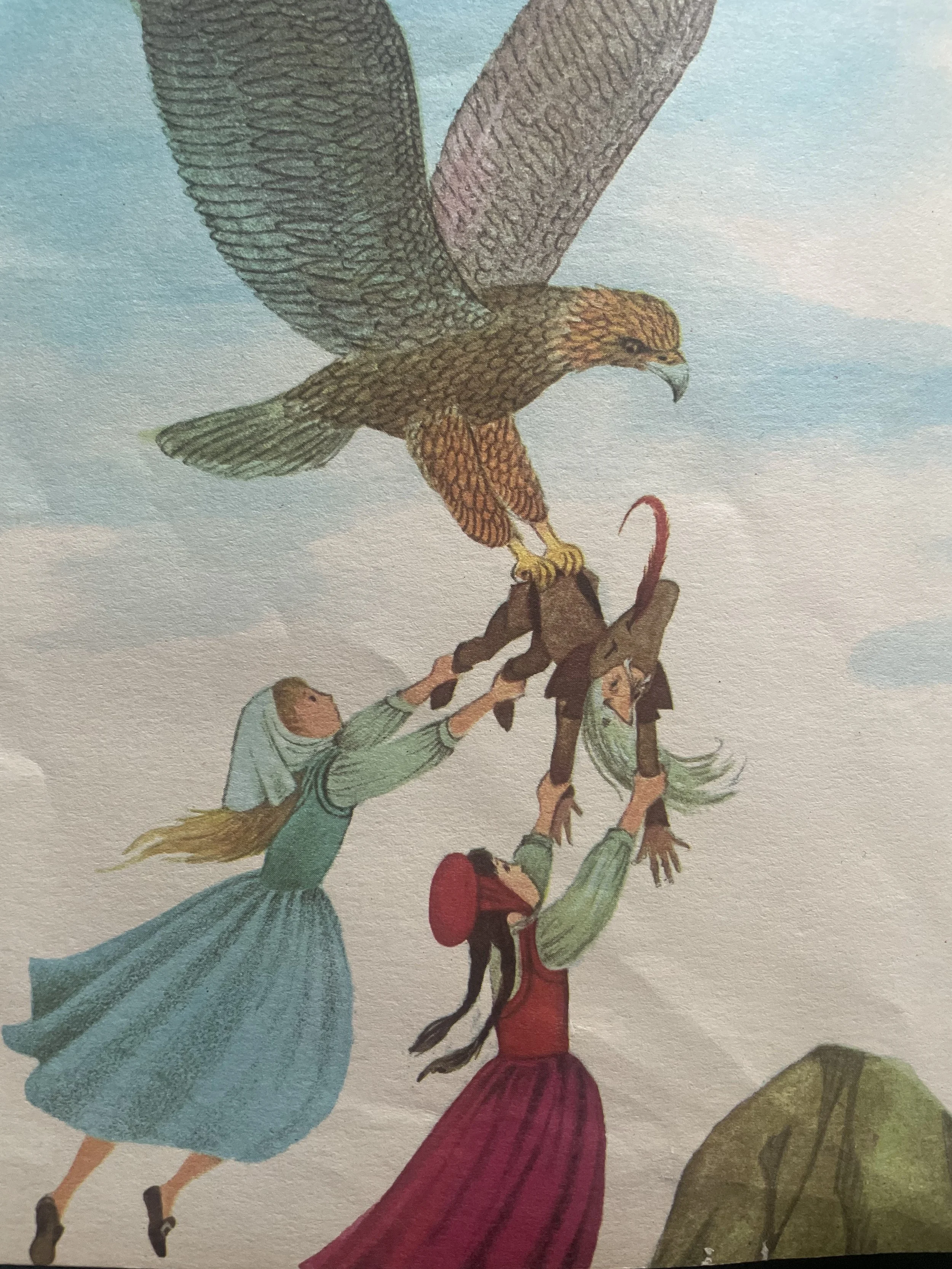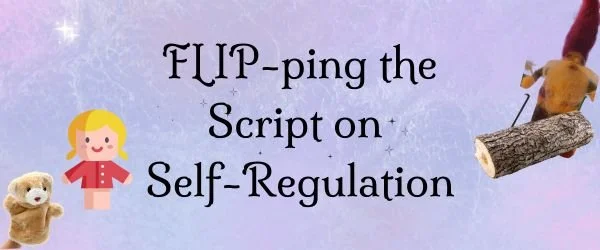Snow White, Rose Red, the Bear and…a Dysregulated Dwarf
Once Upon a Time…
Two girls lived with their widow mother in a cottage at the edge of a forest. Life was good, and the sisters were the best of friends.
One night, a bear knocks at their door, asking for shelter. The girls are scared. Their mother co-regulates with them, and graciously invites the bear in.
Unlike many fairy tale families, this one has all the traits that nurture resilience:
Positive relationships,
Lots of opportunities to use initiative and executive functions
And so MANY examples of co-regulating self-regulation
between the mother and her daughters,
between the two sisters,
between the bear and the girls.
Fast forward to spring. The bear leaves. The girls go wandering and discover a mean-spirited dwarf in the forest. He keeps getting himself into fixes, which the girls generously help him out of.
But is he grateful? Heck no!
He remains a dysregulated cranky pants, and it’s not til the bear swipes him to the ground for threatening the girls that they discover he’s a sneaky thief, too!
AND has cursed the bear, who is actually…wait for it…an enchanted PRINCE!
With a brother!
In true fairy tale fashion, Snow White and Rose Red from the Brothers Grimm, ends with both girls and their mother living resiliently ever after with the princes in a beautiful castle.
While not as well-known as the OTHER Snow White, this Snow White and her family is an interesting tale to share with children as they await the upcoming bombardment of Disney merch.
The variants below are very similar, except for the illustrations. Two (Adams and Spirin) include the angel-like character in the Grimm’s original; Sanderson and Cooney do not.
Pick your favorite and enjoy another Snow White and another dwarf away from the big screen!
Rose Red and Snow White
Retold and Illustrated by
Ruth Sanderson
Large, detailed, realistic illustrations make this a top pick for group sharing
See it read by a lively lady from New Zealand here!
Snow White and Rose Red
Retold and Illustrated by Adrienne Adams
Calm, simple watercolors
Another good choice for group reading because of size and placement of illustrations
Snow White and Rose Red
Retold and Illustrated by Barbara Cooney
Most “natural”-feeling text and conversations
Wonderful facial expressions
Some children may not appreciate the less colorful illustrations (red is the only color used)
Snow White and Rose Red
Retold and Illustrated by Gennady Spirin
Exquisite illustrations give the feeling of Renaissance-era art
Best viewed up close because of dark colors and detail
A little more wordy than other versions
Did someone say…PUPPETS?
There are MANY SEL programs that use puppets to teach self-regulation.
Maybe you’ve heard of Tucker the Turtle?
He’s the puppet poster child for self-regulation “how to” from the Pyramid Model. He’s even the star of his own books!
When I taught first-grade, a fellow teacher came in weekly and performed BABES puppet shows.
A host of animal characters helped her tell scripted stories about family substance use disorders, child abuse, and other dysfunctions that our kids might be experiencing.
Head Start (Tucker) and Edutopia (Sock puppets!) are among the programs that support the idea of using puppets to develop kids’ emotional regulation.
But here’s the thing. You don’t NEED a scripted, packaged SEL program to use puppets to support self-regulation!
All you need is: PUPPETS!
I quickly discovered the link between puppets and self-regulation when I dumped a bunch of my children’s puppets for my class to use. There were…shark puppets.
Within minutes, small hands were wildly smashing those sharks into each other, with lots of roars and snarls! YIKES!
So.
Rule #1 for using puppets to nurture self-regulation is demonstrating how to treat them gently!
Otherwise: they don’t last. (Ask me how I know…!)
I’ve found the best way to do this is by having the puppets set their own boundaries.
“Hey, kids! I’m Boshi the Bear! I know I LOOK huge and ferocious, but if you bash me around, ALL my little stitches will start to tear, and I’ll have to go to the puppet hospital. Where there will be needles and yucky medicine! Ew! So please be gentle, OK?”
The empathy that children have for puppets is one reason they work so well with helping children to identify and verbalize their feelings. So use it!
Snow White and Rose Red has a satisfying cast characters for the kids to act out: a mother, two girls, a bear, a dwarf…even a few princes. (You can also freely add or substitute characters. Remember: Fairy tales are like the loose parts of storytelling!)
But the goal is not to replicate the story, but rather: let the children PLAY with it! Put puppets of any kind in your book area with copies of different variants and see what they come up with!
Do you work with older kids who might be ready to actually put on a puppet show? This blog has a very detailed description of how a mom made the puppets and props for Snow White and Rose Red, if they need inspiration!
A recent newsletter from the Devereux Center for Resilient Children featured a fascinating blog post by the amazing Rachel Wagner.
In the post, she shares how she uses the FLIP IT! strategy for talking through her OWN emotional regulation process, as an adult.
We know that if WE aren’t self-regulated most of the time, we can’t support children in developing these essential life skills. And, just as children don’t enjoy being dysregulated, neither do we!
The blog made me revisit an idea I had several years ago: there are some fairy tale characters in SERIOUS need of reframing their challenging behaviors! 😂
So, what would it be like if the sweet sisters “FLIPped IT on that surly dwarf?
Or the miller’s daughter FLIPped IT on Rumpelstiltskin?
Or…the wicked witches and grumbly giants got FLIPped?
If you already use FLIP IT, all you need is some puppets and you’re ready to roll! The kids will take it from there!
Need an intro and some ideas to get started? See below!
Want to learn more about FLIP IT? There’s a free webinar coming up on April 15, 2025!
Feelings: “Wow, Mr. Dwarf! You seem very frustrated about not being able to get loose from the log!”
Limits: “We get that you’re mad, but please stop calling us names!”
Inquiries: “Do you have ideas about how we could help?”
Prompts: “How about I carefully trim your beard and free you?”
What will YOUR kids come up with?
Do you use puppets with kids?
Is FLIP IT a strategy you’ve found helpful?
What do you think about this OTHER Snow White?
Comment below!









